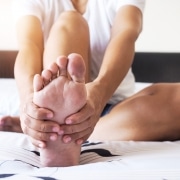What Causes Bone Spurs?
Bone spurs are overgrowths of bone on parts of the body. Bone spurs often form due to osteoarthritis but also can be caused by genetic conditions. They can be painful and hard to tolerate if they are bad enough but can sometimes be managed with healthy lifestyle choices.
Bone spurs form where irritation and inflammation occur in our joints. Over 50% of adults have some bone spurs in their body that never become a medical issue. The most common places for bone spurs to occur are in the feet, hips, neck, and knee area, where a lot of friction occurs when moving.
How Bone Spurs Occur
As we move about during the day, our joints are lubricated with cartilage, an oily and slippery substance that keeps movement friction-free. But as we age our production of cartilage drops, and if we are susceptible, bone spurs can occur.
Bone spurs form when the body improperly produces new bone. A bone spur may develop along the side of the foot. If an individual improperly stands on the side of their feet, then over many years a bone spur may form on the side of their foot to offset balance.
In individuals with osteoarthritis, the reduced cartilage in their joints may prompt their system to improperly produce a bone spur in the affected area to try to offset the lack of cartilage.
A Recent Development
Recently, researchers looking at the skull x-rays of youths in Australia discovered bone spurs on the back of their skulls among a large cohort of individuals. The researchers surmised that this was the result of them using screen devices for large periods of time and that the bone spurs were a recent development that helps offset the frontal tilt of the head when looking at a screen.
This is another example of how bone spurs occur and shows just how our bodies,in their attempt to help us, sometimes end up making another problem. Bone spurs can sometimes be prevented through healthy lifestyle choices. They can be treated and managed with a variety of medical treatment options. Talk to your doctor in Austin, TX about your concerns if you have a bone spur forming, or if you have an existing bone spur that is causing you problems.





